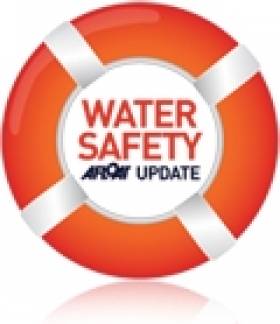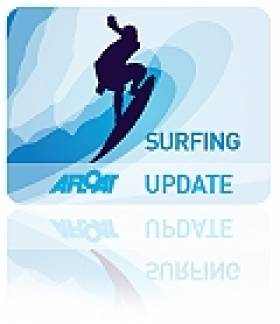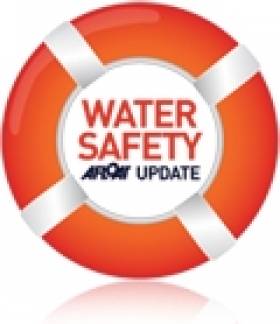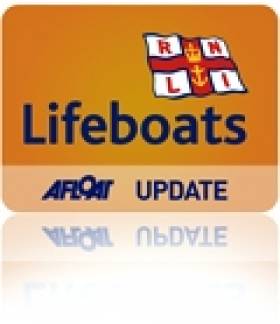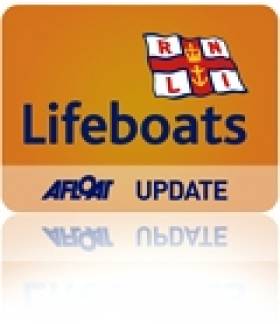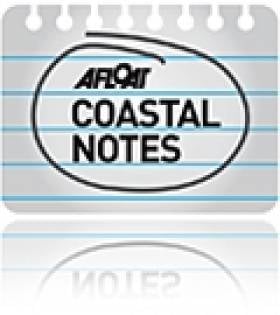Displaying items by tag: Causeway Coast
Causeway Coast Is The Place To Be To See Dolphins In Their Element
#MarineWildlife - The Causeway Coast is fast becoming a mecca for dolphins – and dolphin watchers, as the News Letter reports.
Now regularly spotted from the mainland between Ballycastle and Lough Foyle, the dolphins – which may number as many as 70 – are believed to have followed the Gulf Stream as its warm waters have dropped down towards the north coast.
But they're not just here for a holiday, as food is of the essence – hence their habit of approaching boats in big numbers in search of a bite to eat, or in the hopes of stirring up a big mackerel feast.
Rathlin Island appears to be a particular hotspot for the boisterous cetaceans, but Malin Head in Donegal also seems to be within their swimming grounds, as previously reported on Afloat.ie.
#RNLI - RNLI lifeguards on the Causeway Coast helped to bring a sand dune fire under control at the weekend.
Lifeguards Jenny Thompson, Liam Mullan, James Walton and Jordan Burns were patrolling Benone Strand near Coleraine on Saturday afternoon (16 May) when, shortly after 3pm, they spotted smoke emerging from the sand dunes as they were preparing to enter the water to do some training.
One lifeguard went to investigate the incident some 400m from the rear of the lifeguard hut and observed a large fire which was spreading fast due to a strong easterly wind.
The lifeguards contacted the Northern Ireland Fire and Rescue Service before going to the scene themselves and bringing the fire under control within 10 minutes using fire extinguishers and shovels.
While continuing to maintain an operational and safe beach, the lifeguards ensured that no one was in any danger.
The lifeguards were assisted by staff from the nearby Benone tourist complex who provided the extinguishers, the beach rangers and some members of the Order of Malta who had been providing medical cover for a half marathon which had just finished on the beach.
RNLI senior lifeguard Liam Mullan explained: "The strong easterly wind was a big factor on how fast the fire was growing and how hot it was burning. Thankfully once on scene, we were able to bring the fire under control in about 10 minutes.
"Everyone reacted quickly and worked together using the water to contain the fire to stop it traveling with the wind. We then worked from behind the blaze using the wind to keep the smoke away from us. Using shovels, we brought the flames under control."
Speaking following the incident, Tim Doran, RNLI lifeguard supervisor, said: "While the primary role of a lifeguard is ensuring people’s safety in the water, they also have a duty of care for all members of the public when on land too.
"RNLI lifeguards have a good knowledge of beach access and the surrounding areas and we would encourage any concerned member of the public who comes across such fires to raise the alarm with the lifeguards on patrol who can respond and alert their colleagues in the fire service."
Lifeguards Return To Causeway Coast For Easter Break
#WaterSafety - RNLI lifeguards will be making a welcome return to a number of selected beaches on the Causeway Coast and in Co Down next weekend ahead of the Easter holidays.
After undergoing intensive training in preparation, the charity’s lifeguards will be keeping visitors safe on Tyrella Beach in Co Down and on Benone Strand, Portstewart Strand, East and West Strands in Portrush and Whiterocks on the Causeway Coast.
Lifeguards will begin their patrols on Good Friday (3 April) between 11am and 7pm on the Causeway Coast and between 10am and 6pm in Co Down and continue daily to Sunday 12 April.
Cover will be provided every weekend until the end of June ahead of the summer season, when a daily duty will get underway on all 10 RNLI lifeguarded beaches in Northern Ireland.
"Our lifeguards are looking forward to going on patrol and meeting people who come to the beach," said RNLi lifeguard manager Mick Grocott. "We would encourage visitors to speak to our lifeguards, ask for safety advice, and most importantly call on them should they find themselves in difficulty."
Ahead of Easter, the RNLI has reiterated its advice to people planning a beach trip to stay well away from dangerous cliff edges which have been impacted by recent weather conditions.
Winter storms changed the profile of all the beaches with extensive damage at Whiterocks, Portrush East and Portstewart where there are high and unstable sand cliffs.
The RNLI’s advice for anyone planning a trip to the beach is to: check weather and tide times before you go and if planning to go into the water; only go swimming at a lifeguarded beach, between the red and yellow flags; and avoid using inflatables in strong winds or rough seas.
If you get into trouble, stick your hand in the air and shout for help and if you see someone else in trouble, tell a lifeguard. If you can’t see a lifeguard, call 909 or 112 and ask for the coastguard.
For more safety information on the beach you plan to visit, you can download the RNLI’s Beachfinder app to find lifeguarded beaches and more information.
Surfing Rises On Causeway Coast This Easter Weekend
#Surfing - The News Letter has the lowdown on this weekend's Causeway Coast Surf Festival in Portrush.
This marks the second year of the festival, hosted by the Causeway Coast Surf Club, that mixes surfing with beach and street sports plus music, film and photography, with plenty on offer to entertain the whole family over the Easter weekend.
Aside from the action on the water, highlights are set to be screenings from the Shore Shots film festival that wowed Dublin earlier this month, and a collection of classic Volkswagen camper vans.
The News Letter has more on the weekend's events HERE.
RNLI Surfers Survival Clinics Return To The Causeway Coast
#WaterSafety - The RNLI will host four free Surfers Survival Clinics next weekend, Saturday 8 and Sunday 9 March, on the East Strand in Portrush.
The clinics, which are run by the charity’s lifeguards, are open to surfing enthusiasts of all abilities and are aimed at developing both knowledge and skills in surf safety.
The RNLI programme, which is now being run for the third year in Northern Ireland, will show surfers how to develop their rescue techniques, learn basic first aid and surf etiquette and learn them how to help themselves and others if they get into trouble in the surf.
More people are taking to the sea every year for enjoyment and the Causeway Coast is a popular area for water sports including surfing and body boarding. The clinics have proved popular with surfers who use them as a chance to brush up on their knowledge and skills and pass on their experiences to others.
There are 10 seasonal RNLI lifeguarded units in Northern Ireland, each equipped with lifeguards ready to respond in the event of an emergency. RNLI lifeguards aim to reach any casualty up to 300m from shore within the red and yellow flags within three and a half minutes. Lifeguards are also on hand to provide advice and assistance to all water users.
Last year, Northern Ireland experienced one of its hottest summers for years and this was reflected in a busy season for the lifeguards located across the Causeway Coast in Co Down.
In all, RNLI lifeguards responded to 302 incidents compared to 159 in 2012 and came to the aid of 330 people who found themselves in difficulty, which is an increase of 153 from the year before.
The Causeway Coast, where there are seven units, was the busiest area, with lifeguards responding to 222 incidents and assisting 247 people.
Speaking ahead of next weekend’s clinics, RNLI lifeguard supervisor Tim Doran said: “Surfers of all abilities will benefit from the Surfers Survival Clinic. Amateur surfers will get the chance to learn safety skills, duck diving and surf etiquette which should help them minimise any injuries should they get into trouble.
“The more experienced surfer will be shown rescue and first aid demonstrations so that they can continue developing their skills in the surf.”
Spaces are limited for each session so advance booking is essential to avoid disappointment. Anyone who wishes to take part in the RNLI’s Surfers Survival Clinic should be aged 18. To book a space or for more information contact Tim on +44 (0) 77 899 25998.
Woman Rescued From Cliff Fall On Causeway Coast
#Rescue - Two coastguard units, the Portrush lifeboat and a Royal Navy helicopter from Scotland were involved in the rescue of a woman who had fallen 50 feet off a cliff on the Causeway Coast at the weekend.
As the Belfast Telegraph reports, the woman, believed to be in her 20s, had been walking along the top of the cliff between Ballycastle and Ballintoy in Co Antrim in the early hours of Saturday morning when she apparently slipped and fell.
Search and rescue teams jumped into action when a car was spotted near Carrick-a-rede rope bridge some hours later, and the woman as located at the base of a nearby cliff below Portaneevy Viewpoint just after 9am.
The woman has sustained multiple injuries and was suffering the effects of shock and hypothermia, but was successfully airlifted to Causeway Hospital in Coleraine where her condition was described yesterday as stable.
The Belfast Telegraph has more on the story HERE.
#RNLI - Portaferry RNLI is looking for new volunteer crew members to join its search and rescue service in Co Down.
The station currently has 17 lifeboat and two shore crew to cover its inshore service on Strangford Lough but is now calling on new volunteers to come forward and find out how they can get involved in helping the charity continue to save lives at sea.
To that end, the station will be hosting two open days early next month for all interested candidates to learn more.
"We are looking for anyone aged 17 years and over who is willing to offer some of their free time to join what I believe to be, one of the most exhilarating and rewarding voluntary services that is out there," said lifeboat operations manager Brian Bailie.
"Every volunteer receives first class training from the RNLI and learns new skills which can benefit them in many walks of life. Lifeboat crew members need to have a reasonable level of fitness, have good eyesight and not be colour-blind."
He added: "Anyone who would like to volunteer but feels they would not meet the requirements for lifeboat crew should in no way be put off, as shore crew also play an essential role in the launch and recovery of the lifeboat when it goes on service."
For anyone who feels they have the time and commitment to volunteer for the charity which is on call 24 hours a day, 365 days a year, is asked to email Brian at [email protected].
Alternatively, prospective volunteers can come along to the station’s open days from 7-9pm next Tuesday 7 May or from 2-4pm next Saturday 11 May.
Elsewhere in Northern Ireland, primary school children will have the opportunity to hit the surf with RNLI lifeguards over the next month.
The charity’s ‘Hit the Surf’ programme runs from 7 May to 7 June on the East Strand Beach in Portrush.
Aimed at primary five to seven pupils aged eight to 11, the programme - which is expanding to accommodate more schools this year - gives children a unique opportunity to gain practical lessons in lifesaving and beach safety. All equipment is provided free of charge.
Each session lasts two-and-a half-hours and includes a theory lesson on staying safe at the beach, the role of beach lifeguards and the RNLI, and detailed information on flags and rip currents.
There are practical lessons in lifesaving and surf based skills, while lifeguards aim to build pupils confidence in the sea. Children also learn about the local hazards and the beach environment.
Sessions are still available for schools who want to book pupils in. For more information contact Jessica on 0777 441 4208 or email [email protected]
Last year RNLI lifeguards located on beaches in Co Down and along the Causeway Coast responded to 158 incidents and assisted 176 people who found themselves in difficulty.
RNLI Lifeguards Providing Easter Beach Cover In Northern Ireland
#WaterSafety - RNLI lifeguards will provide Easter cover for the first time on three of the most popular family beaches in Northern Ireland.
For the second year running, lifeguards will be patrolling Tyrella Beach in Co Down, and for the third year will be ready to offer safety advice and assistance on Benone Strand on the north coast.
In addition this Easter, lifeguards will also be patrolling Portstewart Strand, Portrush East Strand and Whiterocks beach, all of which are located along the Causeway Coast.
The cover commences on Good Friday 29 March and will run throughout Easter week until Sunday 7 April.
Despite the unseasonal weather, the charity’s highly trained lifeguards will be ready to assist visitors who brave the elements and take a trip to the seaside over the Easter break.
The lifeguards will operate on Benone, Portstewart, East Strand and Whiterocks from 11am to 7pm, and from 10am to 6pm on Tyrella Beach.
RNLI regional lifeguard manager Mike Grocott said: "Our highly trained lifeguards spot potential dangers before they develop, and are on hand to give appropriate safety advice and respond immediately if anyone gets into difficulty.
"Because our lifeguards work closely alongside our volunteer lifeboat crews, it means the RNLI offers beachgoers and water-users a seamless rescue service from beach to open sea."
The RNLI started providing lifeguard cover on Northern Ireland beaches in 2011, working with Coleraine Borough Council, Limavady Borough Council and the National Trust - and going into its third season now has lifeguards on 10 beaches.
Last year, lifeguards in the areas of Newry and Mourne District Council, Down District Council and the Causeway Coast together responded to 158 incidents and assisted 176 people.
Speaking ahead of the Easter holidays, RNLI lifeguard supervisor Tim Doran encouraged anyone planning a trip to the beach to keep safe.
"Always swim at a lifeguarded beach. Never use inflatables in strong winds or rough seas and check tide times before you go," he said. "If you get into trouble, stick your hand in the air and shout for help and if you see someone else in trouble, tell a lifeguard. If you can’t see a lifeguard, call 999 or 112 and ask for the coastguard."
The RNLI is also encouraging anyone planning a trip to the seaside this year to download its ‘Beach Finder’ mobile app.
The handy app makes it easy to find the nearest lifeguarded beach, and gives users a wealth of beach safety information at their fingertips.
Real-time weather information and a five-day forecast for each location is also included with the app – ideal for anyone wondering whether they’ll need to pack their suncream or waterproofs!
The app is available to download free of charge on both Android and iOS devices from www.rnli.org/beach.
RNLI Calls For Causeway Coast Lifeguards
#RNLI - The RNLI is currently recruiting lifeguards to work on 10 Northern Ireland beaches for the forthcoming season including seven beaches along the Causeway Coast.
The successful candidates will become part of the RNLI’s beach lifeguard team who will monitor and advise the public of any dangers or hazards and carry out rescues.
The charity provides a seasonal service on seven beaches along the Causeway Coast including Benone, Downhill, Castlerock, Portstewart Strand, Portrush West Bay & East Strand and Whiterocks.
This is the third year the lifeboat charity’s lifeguards have provided a lifeguard service in Northern Ireland, offering beach-goers and water users a seamless rescue service from the beach to open sea working alongside RNLI lifeboats.
The closing date for applicants is Sunday 17 February 2013. A detailed description of the RNLI lifeguard role is available at www.rnli.org/lifeguards.
A key part of an RNLI lifeguard's job is to spot dangers before they develop, and 95% of their role is preventative. Their presence on the beach provides reassurance to the public while also offering any help or advice to help people enjoy their beach experience in a safe environment.
To many beach users they are a reassuring presence but they also carry out many other important functions. They assess the conditions on the beach and place zone flags and warning signs to advise the public. They carry out rescues to help people who have got into difficulty in the water or who need assistance. They also provide first aid, help with lost children, give advice, report hazards, and assist with beach safety and education programmes. They train and preform to their duties to the highest RNLI standards.
The RNLI has about 50 positions available and many former lifeguards are expected to return for the new season. However, there are a number of positions vacant and the charity would like to hear from interested people. The minimum age for applicants is 16 years and candidates must have a high level of fitness.
Mike Grocott, RNLI lifeguard manager for Northern Ireland, said: “RNLI lifeguards are a vital part of the charity’s lifesaving service. Last year they dealt with 126 incidents and assisted 142 people on the Causeway Coast.
"It is a fantastic opportunity for people to do a job that is both fulfilling and enjoyable. Our lifeguards speak to hundreds of people over the course of the season and get the opportunity to do something important and rewarding in the community.
"The ideal applicant will already hold an International Lifesaving Approved Beach Lifeguard Award but if candidates need to get qualified we can put them in touch with local providers of courses.”
Limavady and Coleraine Councils along with the National Trust provide funding towards the lifeguards’ wages while the RNLI funds the training and equipment.
Young Kayakers Recognised at NI Clean Coast Awards
#COASTAL NOTES - A group of young kayaking enthusiasts from Northern Ireland have taken the top spot in their category at the Coca-Cola Clean Coast Awards, as the Coleraine Times reports.
The Causeway Coast Kayak Association comprises 150 young people learning canoeing and other skills on the Causeway Coast in North Antrim.
They were recognised for their involvement in coastal cleanups around Ramore Head and along inland waterways such as the rivers Roe and Bann.
NI Environment Minister Attwood, who was on hand to present the award, said: “It is great to see community and youth groups taking pride in their own neighbourhood and doing something about littering which is such a blight on our coast and around our inland waterways.”
The Coleraine Times has more on the story HERE.




























